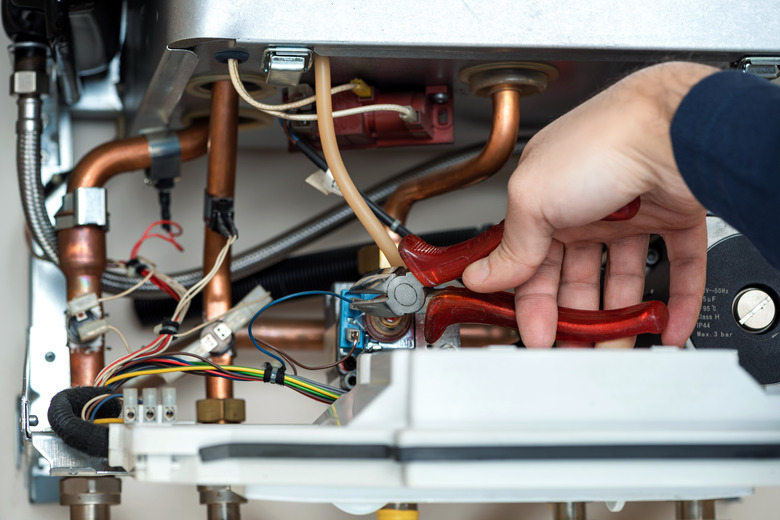How To Know If Your Pilot Light Is Out
We may receive a commission on purchases made from links.
The technical term for a pilot light is a standing pilot, which is a small flame that's continually burning. Its function is to ignite the gas burner flame in a natural gas or propane water heater, furnace or boiler, and if it goes out, the appliance won't operate. The failure of your gas furnace to provide heat or your gas water heater to provide hot water is usually your first indication that the pilot has been extinguished.
Standing pilots aren't common in new appliances anymore, having largely been replaced by spark ignitors and hot surface ignitors, which are electronic devices that operate only when needed. Some low-end appliances still have pilot lights, though, as do older appliances that have been in service for 20 years or more. If your gas appliance has a standing pilot, you'll see a gas control knob on the front of the appliance with three settings, "off," "on" and "pilot," and you'll be making use of that knob to restart the pilot. First, you have to verify that the flame has indeed gone out.
How to Check the Pilot Light
How to Check the Pilot Light
Loss of heat or hot water is a pretty good sign that the pilot light has gone out, especially if the appliance in question is a furnace, and the blower is still working. However, when it comes to furnaces, a few other components could cause a gas shutdown, so you should check the pilot visually, and fortunately, that's as easy to do for a furnace as it is for a water heater.
If you're checking a furnace pilot, you'll have to remove the furnace cover to locate the gas control knob, whereas on a water heater, it's prominently placed on the front of the tank about a foot above the floor. Once you've found the gas control knob, you're halfway there. Note the cavity into which the tubes extend from the gas control; inside that cavity is where you should see the pilot burning.
You may have to crouch down to do it but look inside that cavity, and if you see a small bluish flame about an inch high, the pilot is on. If you don't see that flame, then the pilot has gone out.
Why Has the Pilot Gone Out?
Why Has the Pilot Gone Out?
A standing pilot flame is like that of a match, and a good strong blast of air can put it out. If that's what happened, you should have no trouble restarting it, although you'll probably want to take steps to stop it from getting blown out again. It's also possible that the appliance ran out of gas because your propane tank is empty, in which case you obviously won't be able to relight the pilot. Some other possibilities aren't as clear cut.
There could be a problem with the thermocouple, which is a safety device that closes the gas valve when the flame goes out. If the thermocouple is responsible, you'll be able to start the pilot flame, but it won't stay lit. Debris blocking the pilot orifice could also be the culprit, and if so, you might be able to restart the pilot, but it will burn with a flickering orange hue and will go out again in a few minutes, hours or days.
Restart the Pilot Safely
Restart the Pilot Safely
Before you restart the pilot, do a smell test and if you detect gas, stop and call an HVAC pro. The odor could indicate a leak, and a flame could cause an explosion.
In the absence of any unusual odors, follow the instructions for lighting the pilot displayed on the appliance label. Some units have a piezoelectric spark ignitor to get the pilot flame going, and if so, you'll see a green or red button next to the gas control knob. Remember to hold in the knob for 10 to 20 seconds after the flame ignites to give the thermocouple time to warm up.
